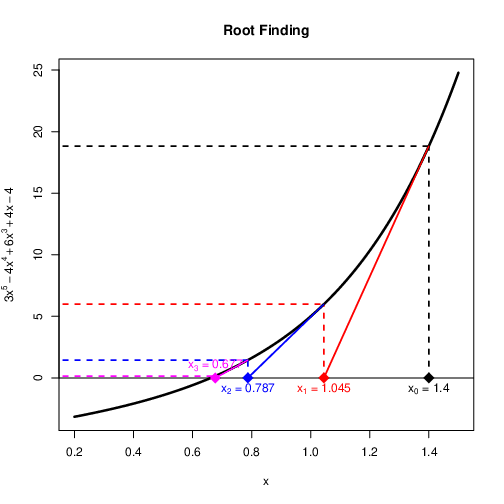Introduction to Optimization¶
Feng Li
School of Statistics and Mathematics
Central University of Finance and Economics
Input and output¶
For many of these problems there is some control over the input
Maximizing Revenue - Price
Minimizing Costs - Number of Workers
Minimizing Delivery Time - Driving Route
Maximizing Financial Returns - Portfolio weights
Optimization in Statistics¶
In statistics, many estimators maximize or minimize a function
Maximum Likelihood
Least Squares
Method of Moments
Posterior Mode
Suppose we want to find an minimum or maximum of a function $f(x)$
Sometimes $f(x)$ will be very complicated
Are there computer algorithms that can help?
YES!
Newton’s Method
Quasi-Newton
Nelder Mead
Newton’s Method¶
Finding a root¶
Consider the problem of finding the root or zero a function.
For the function $g(x)$ the root is the point $x^*$ such that $g(x^*)=0$
An algorithm for solving this problem was proposed by Newton and Raphson nearly 500 years ago.
We will use this algorithm to find the root of $g(x)=3x^5-4x^4+6x^3+4x-4$
gx<-function(x){
y=(3*(x^5))-(4*(x^4))+(6*(x^3))+(4*x)-4
return(y)
}
dgx<-function(x){
y=(15*(x^4))-(16*(x^3))+(18*(x^2))+4
return(y)
}
gridx<-seq(-2,2,0.01)
gridy<-gx(gridx)
plot(gridx,gridy,"l",main='Root Finding', ylim= c(-200, 100),
xlab = 'x', ylab=expression(y=3*x^5-4*x^4+6*x^3+4*x-4))
lines(c(-2,2),c(0,0))
Finding the Tangent¶
To find the tangent evaluate the first derivative of $g(x)$.
The function is $$g(x)=3x^5-4x^4+6x^3+4x-4$$
The first derivative is $$g'(x)=15x^4-16x^3+18x^2+4$$

Find the crossing point¶
- Find the crossing point From basic Geometry
- Rearrange
Stopping Rule¶
With each step the algorithm should get closer to the root.
However, it can run for a long time without reaching the exact root
There must be a stopping rule otherwise the program could run forever.
Let $\epsilon$ be an extremely small number e.g. $1\times 10^{-10}$ called the tolerance level
If $|g(x^*)|<\epsilon$ then the solution is close enough and there is a root at $x^*$
Newton-Raphson algorithm for root finding¶
Select initial value $x_0$ and set $n=0$
Set $x_{n+1}=x_{n}-\frac{g(x_n)}{g'(x_n)}$
Evaluate $|g(x_{n+1})|$
If $|g(x_{n+1})|\leq\epsilon$ then stop.
Otherwise set $n=n+1$ and go back to step 2.
Your task: Write R/Python code to find the root¶
$g(x)=3x^5-4x^4+6x^3+4x-4$
Tips:
Write functions for $g(x)$ and $g'(x)$ first.
These can be inputs into a function that carries out the Newton Raphson method. Code should be flexible.
Use loops!
Your task: a different target function¶
Now use your Newton-Raphson code to find the root of $g(x)=\sqrt{|x|}$
The derivative has two parts $$g'(x)=\left{
\begin{array}{l} 1/(2\sqrt{x})\quad\mbox{if $x>0$}\\ -1/(2\sqrt{-x})\quad\mbox{if $x<0$} \end{array} \right.$$Use 0.25 as the starting value.
Learn from mistakes¶
Newton-Raphson does not always converge
Be careful using while. Avoid infinite loops.
Don’t always assume the answer given by code is correct. Check carefully!
Print warning messages in code
For some functions, using some certain starting values leads to a series that converges, while other starting values lead to a series that diverges
For other functions different starting values converge to different roots.
Be careful when choosing the initial value.
Newton-Raphson doesn’t work if the first derivative is zero.
When can this happen?
Rough Proof of Quadratic Convergence¶
Can we prove anything about the rate of convergence for the Newton Raphson Method?
To do so requires the Taylor Series
Let $f(x)$ have a root at $\alpha$. The Taylor approximation states that
$$f(\alpha)\approx f(x_n)+f'(x_n)(\alpha-x_n)+\frac{1}{2}f''(x_n)(\alpha-x_n)^2$$
The quality of the approximation depends on the function and how close $x_n$ is to $\alpha$
Since $\alpha$ is a root, $f(\alpha)=0$ This implies
$$0\approx f(x_n)+f'(x_n)(\alpha-x_n)+\frac{1}{2}f''(x_n)(\alpha-x_n)^2$$
Dividing by $f'(x_n)$ and rearranging gives: $$\frac{f(x_n)}{f'(x_n)}+(\alpha-x_n)\approx\frac{-f''(x_n)}{2f'(x_n)}(\alpha-x_n)^2$$
More rearranging $$\alpha-\left(x_n-\frac{f(x_n)}{f'(x_n)}\right)\approx\frac{-f''(x_n)}{2f'(x_n)}(\alpha-x_n)^2$$
The term in brackets on the left hand side is the formula used to update $x$ in the Newton Raphson method $$(\alpha-x_{n+1})\approx\frac{-f''(x_n)}{2f'(x_n)}(\alpha-x_n)^2$$
This can be rewritten in terms of errors $e_{n+1}=\alpha-x_{n+1}$ and $e_n=\alpha-x_n$ $$e_{n+1}\approx\frac{-f''(x_n)}{2f'(x_n)}e_n^2$$
Conclusion¶
Why did we spend so much time on finding roots of an equation?
Isn’t this topic meant to be about optimization?
Can we change this algorithm slightly so that it works for optimization?